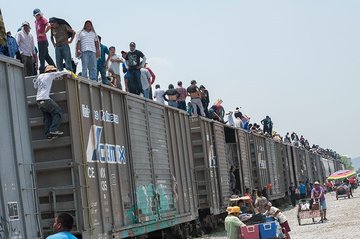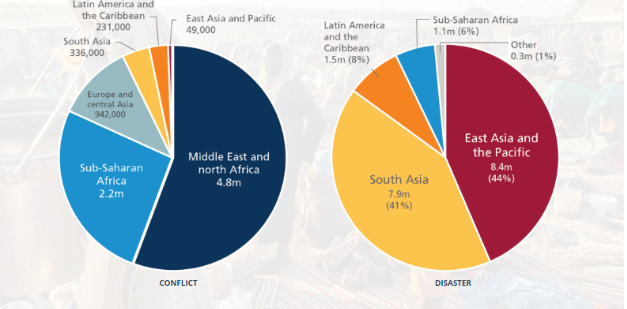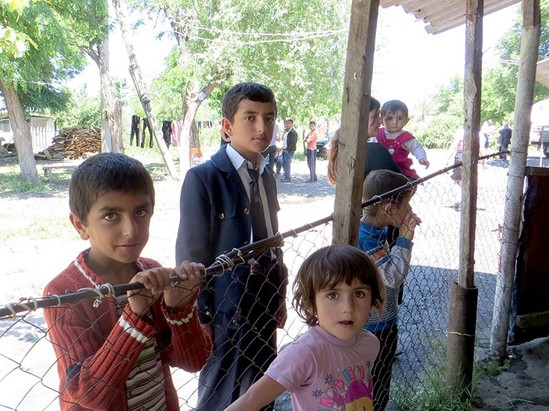|
What it means to flee... By Jessie Stein There is a lot of confusion when deciphering the difference between an Internally Displaced Person (IDP) and a refugee. Although both classifications of people have undergone social injustices or armed conflict in their home countries, the two are actually different. To begin, both refugees and IDPs are displaced people; however, where they choose to go after being displaced is what sets them apart. IDPs are forced out of their homes to avoid violence and man made disasters, but choose not to cross borders, meaning legally they are not defined as refugees. A refugee is someone who is forced to flee their home and cross national boundaries because they can no longer return home safely. Did you know that in 2015 there were 8.6 million new displacements by conflict and violence in 28 countries? That same year Colombia ranked 8th in the list of countries with the most new displacement due to these issues. One of our IAMCBOB Scholars Jose Martinez was an IDP in Colombia who was able to answer some questions about his lifestyle growing up.
When asked these questions, Jose answered with this: “I lived in a town called Santa Barbara on known block like the passages of palms, in 2006 the Farc came to this block, I studied and lived there with my mom, my older brother and all of my aunt’s family. We were all displaced that year. To clarify: a person is not displaced only while finding a place to live, having forcibly left the place where you live is something that stays with you for life. Since my aunt is a teacher I had no problem studying while I got settled in a new place.” Below are regions with the most new displacement in 2015.  Although Jose was fortunate enough to be able to attend school, many displaced kids are faced with different barriers in regards to education, which hinders their ability to learn the way most students do. Although there can be schools in IDP camps, they are usually under-funded and only provide primary education. Additionally, there are huge safety risks with IDP children due to their unsafe residences. These kids could face issues such as stepping on a mine or military roadblocks on their way to school, or even be at risk for sexual violence, especially for females. It was also found that 40.8 million people were internally displaced worldwide as the result of conflict and violence. Another huge barrier to education for IDP children is a loss of documentation, which can inhibit children from having the opportunity to attend school. Even if IDP children are able to attend school, there is the issue of language barriers and discrimination. Children who don’t speak the same native tongue as others in the schooling system might feel discouraged or embarrassed and won’t want to return. They may even be alienated as an IDP and segregated between IDP and non-IDP children, and can even face discrimination from their teachers due to their status as internally displaced.  Lastly, although primary education is free, there is illegal levying of school fees, which forces IDP families to choose between food and school. Food and school are necessities in life that no child or family should ever have to choose between; however, since most IDP parents lack sufficient funds, they are are unable to pay for schooling materials. If families are very tight on money, some children are needed to help support their families financially, and therefore, do not have the time to also attend school. Now that and IDP has been fully explained, let’s break down the differences between that and a refugee. As stated earlier, a refugee is a displaced person who has crossed national borders because returning back to their home residence is too unsafe. Under Article 1 of the 1951 UN Convention, a refugee is defined as: “owing to well-founded fear of being persecuted for reasons of race, religion, nationality, membership of a particular social group or political opinion, is outside the country of his nationality and is unable or, owing to such fear, is unwilling to avail himself of the protection of that country.” The definition suggests that there are certain requirements in order to be considered a refugee. One is to have presence outside of their home country, along with the “incapacity to enjoy the protection of one’s own state,”. Another condition is to have a justifiable fear of persecution. This legal term was coined purposely to set IDPs and refugees apart from one another. Because displaced persons must forcibly leave their homes, and their habitual country’s borders, they are legally defined as refugees. Similarly to IDP struggles with education, refugees face many of the same realities. Refugees must also deal with discrimination and embarrassment from not speaking the home country's native tongue. As well, refugee families lack sufficient funds to afford school materials and may even need their kids to help support financially, which would hinder their ability to receive an education. Although both classifications of people are legally defined as being different, they face many of the same issues, especially in regards to education. The two groups of people have undergone similar social injustices and armed conflict that forced them out of their homes, but choose to flee differently. IDPs stay within their countries borders yet still have a hard time receiving an education or supporting themselves sufficiently. Refugees have certain protections under law, which helps them a little more; however, still must face harsh realities when entering a new world. We believe every child deserves an education so they can make a better life for their families and themselves. We strive to generate awareness and educate on these horrific issues so we can help those affected get similar opportunities as we are so fortunate to have. Presentations will be going on at all our Student Chapters, find yours below and make sure to attend! Florida State University: February 15th By Naseam Jabberi University of Florida: February 21st By Mariam Hussein University of Central Florida: February 22nd By Casey McCarthy Sources: www.unhcr.org/en-us/figures-at-a-glance.html http://www.internal-displacement.org/globalreport2016/pdf/2016-global-report-internal-displacement-IDMC.pdf http://www.internal-displacement.org http://www.internal-displacement.org/globalreport2016/ http://www.internal-displacement.org/database/country/?iso3=col http://www.unhcr.org/3b66c2aa10.html https://epthinktank.eu/2015/10/27/refugee-status-under-international-law/ PowerPoint Schedule IDP Graphs A great article by the "Right To Education Project" enumerates the different barriers internally displaced children face in regards to education. The barriers are listed as the following:
Read more about the article here! Copy and paste this link: http://www.right-to-education.org/node/619
1 Comment
|
Archives
July 2021
|
|
Follow Us |



 RSS Feed
RSS Feed